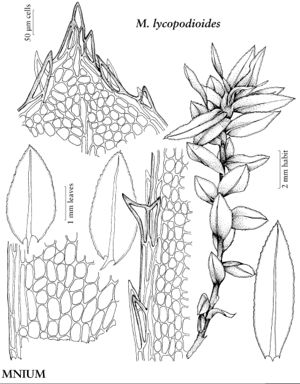Difference between revisions of "Mnium lycopodioides"
Sp. Musc. Frond. Suppl. 2(2,1): 24, plate 160 [bottom]. 1826.
FNA>Volume Importer |
FNA>Volume Importer |
(No difference)
| |
Revision as of 19:45, 24 September 2019
Plants (1–)2–4(–7) cm. Stems red, brown, or sometimes yellowish brown. Leaves green to dark green, contorted and twisted when dry, narrowly elliptic, ovate-elliptic, or ovate-oblong, 3–4(–6.5) mm; base long-decurrent; margins reddish brown, 2-stratose, toothed to below mid leaf, teeth paired or sometimes single near apex, long, sharp, occasionally short and blunt; apex acute, rounded-acute, or obtuse, apiculate or cuspidate, cusp sometimes toothed; costa percurrent or excurrent, distal abaxial surface toothed; medial laminal cells ± isodiametric or short-elongate, (17–)22–40 µm, smaller towards margins, often in longitudinal rows, not in diagonal rows, usually strongly collenchymatous, blue postmortal color absent; marginal cells linear, in 2 or 3 rows. Sexual condition dioicous. Seta single. Capsule yellowish or yellow-brown, 2.5–6(–7) mm; operculum short-rostrate; exostome greenish yellow. Spores 19–30 µm.
Phenology: Capsules mature summer.
Habitat: Shaded, often calcareous rock or cliffs, banks along streams, tree bases, logs
Elevation: low to high elevations
Distribution

Greenland, Alta., B.C., Man., N.B., Nfld. and Labr., N.W.T., N.S., Nunavut, Ont., P.E.I., Que., Yukon, Conn., Idaho, Maine, Mass., Mich., Minn., Mont., Nebr., N.H., N.Y., Oreg., Pa., R.I., S.Dak., Vt., Wash., Wyo., Europe, Asia.
Discussion
Mnium lycopodioides is often difficult to separate from M. marginatum. This is reflected in herbarium collections where many, in particular sterile, specimens of M. marginatum have been identified as M. lycopodioides. Mnium lycopodioides usually has narrower leaves, although some collections of M. marginatum have narrow leaves, with narrow leaf margins composed of two or three rows of cells. Mnium lycopodioides has a shorter rostrum on the calyptra, a useful character with fertile collections.
Selected References
None.
